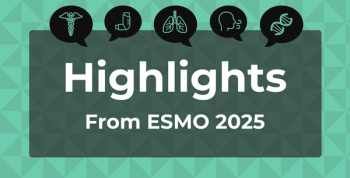
Targeting Progression: Amivantamab’s Role in NSCLC After Osimertinib

Amivantamab's role in non–small cell lung cancer (NSCLC) has been a highlight of the lung cancer space this year, with the 2 most recent approvals based on data from the MARIPOSA and MARIPOSA-2 trials.
For the FDA’s
We spoke with Martin Dietrich, MD, PhD, thoracic oncologist with The US Oncology Network and Cancer Care Centers of Brevard in Orlando, Florida, about the third approval, and here we continue the discussion by learning more about the original MARIPOSA trial and how clinicians pivot from managing their patients’ care to managing their patients’ care while on a clinical trial.
This transcript has been edited for clarity.
Transcript
How do the findings from MARIPOSA feed into the results we see MARIPOSA-2?
MARIPOSA-2 is a follow-up study for the first-line treatment with EGFR, and especially looking at patients that progressed on osimertinib. As you know, the targeted therapies work very well for a while, and then when patients progress, we oftentimes are in a difficult position to find the right next line therapy. We always recommend genetic testing in the meantime. There may be changes, but oftentimes the EGFR mutation is still present. We see some escape through C-MET as well. So it was a logical choice to consider EGFR and MET dual targeting in an additional follow-up study to first-line osimertinib, which again has been the standard of care for more than 90% of our patients.
The study randomized 3 arms. Chemotherapy, which was a legacy standard, we never really prospectively tested it against chemotherapy plus amivantamab vs chemotherapy plus amivantamab and lazertinib, so essentially continuing a third-generation EGFR TKI [tyrosine kinase inhibitor]. And what we found is that both amivantamab and amivantamab/lazertinib additions to chemotherapy significantly extended progression-free survival in the postprogression setting, but that the benefit to side effect ratio seemed to be more favoring amivantamab plus chemotherapy alone. There was some unexpected hematologic toxicity with the quadruplet, including lazertinib, so that arm didn't get moved forward.
So we have a first postprogression regimen that has been approved that is actually evidence-based with chemotherapy plus amivantamab. So it's a very good option if a patient progresses on osimertinib. We don't have a specific genetic escape pathway that we can identify. This is really the standard of care with particular interest in patients that have on-target alterations in EGFR or C-MET, which is an evolving biomarker that we don't routinely use in clinic, but certainly has brought us a lot closer to utilizing C-MET as a protein of interest.
How do you manage patients who were under your care, but now are being treated through a clinical trial?
When we identify patients that are suitable for clinical trials, we still remain involved in the patient's care. We follow patients to ensure that their care can be delivered as close to their home as possible, and we follow them carefully for progression and other events in case any additional therapies are needed.
We try to enroll as many patients as possible. We're always striving to improve standard of care for patients. Sometimes this happens under our own umbrella, or sometimes a patient is getting a new trial in a different institution. And so we stay in very close touch with the investigators. We oftentimes work very closely together and keep the channel of communication open so that we have the patient under dual care.
I think for patients, it's actually a great opportunity. They're not only seeing 2 physicians—it’s always good to have your work double checked—but there's an advantage of accessibility. You get an additional layer of connectivity with your care team. So it is always an aim for us to find clinical trials that we think have a high potential to improve our standard of care.
Newsletter
Stay ahead of policy, cost, and value—subscribe to AJMC for expert insights at the intersection of clinical care and health economics.







































